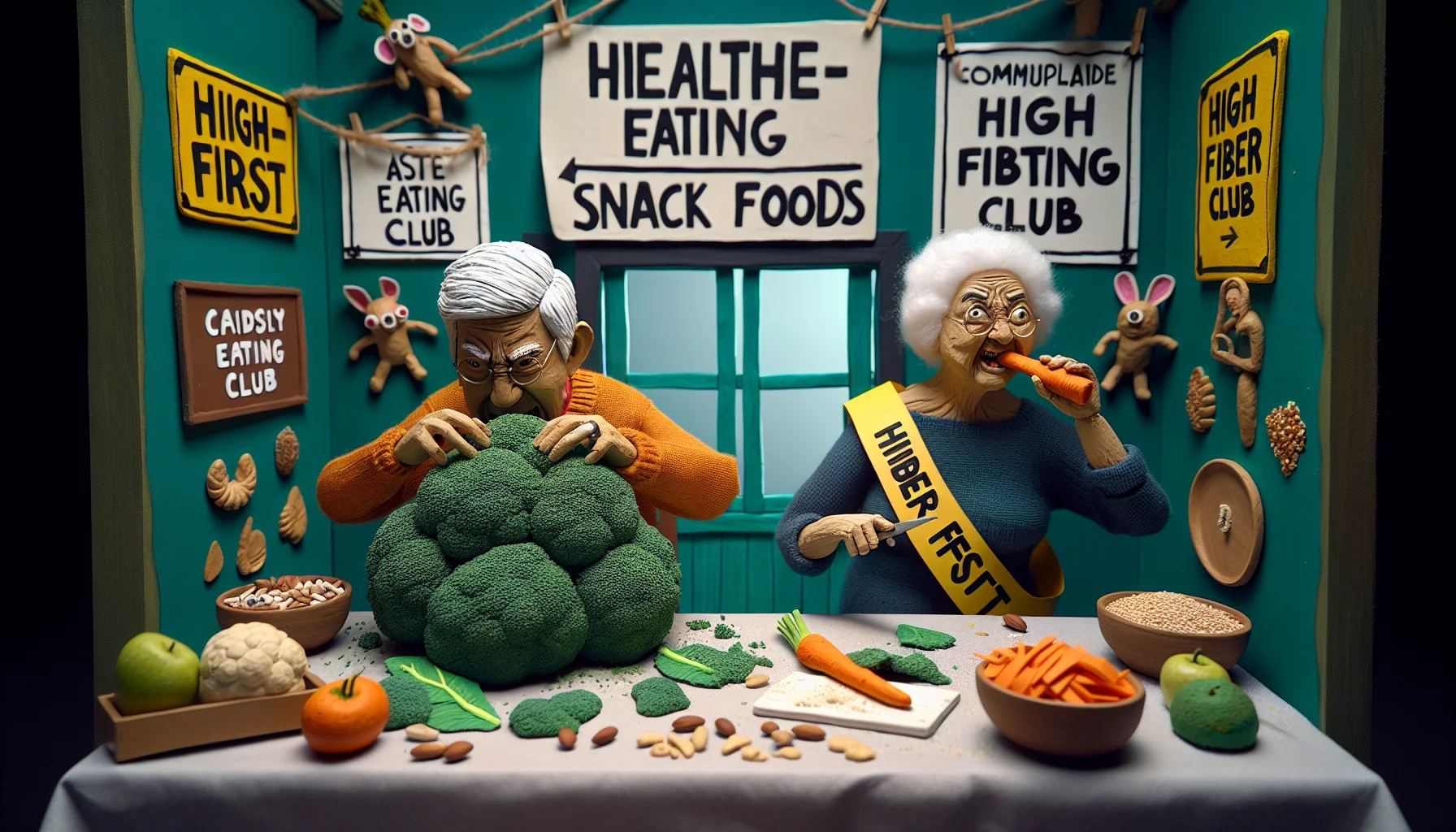Snack foods high in fiber Quiz
Test Your Knowledge
Question of
Understanding Fiber in Snack Foods
The Role of Fiber in Your Diet
Fiber is a nutritional powerhouse, an unsung hero that's vital for maintaining good health. It's found in various plant-based foods and comes in two forms: soluble and insoluble. Each plays a unique role in your wellness journey, contributing to overall dietary balance.
Integrating fiber into your diet isn't just about following recommendations; it's about embracing a lifestyle change that can significantly enhance your well-being. The average adult should aim for a daily intake of around 25 to 30 grams of fiber, yet most people fall short of this goal.
Benefits for Digestive Health
Fiber is the go-to nutrient for keeping your digestive system running smoothly. Think of it as the body's natural broom, sweeping through your intestines and helping everything flow seamlessly. A consistent intake can help prevent constipation and maintain bowel health.
It's not just about comfort; high-fiber diets are linked to a lower risk of developing digestive conditions like diverticulitis, hemorrhoids, and even certain types of cancer. It's clear that fiber deserves a spotlight in your daily meals!
Impact on Blood Sugar Levels
When it comes to blood sugar control, fiber is a true champion. It slows down sugar absorption, preventing those dreaded spikes and crashes that can occur after eating refined snacks. This regulatory effect is crucial for individuals managing diabetes or insulin resistance.
Moreover, the steadying influence of fiber on blood glucose contributes to sustained energy levels throughout the day. This makes high-fiber snacks an excellent option for maintaining focus and avoiding lethargy after meals.
Weight Management Advantages
Fiber might just be your best friend when it comes to weight management! Foods high in fiber tend to be more filling, which means they can help curb hunger and reduce calorie intake without sacrificing satisfaction.
Furthermore, because high-fiber foods generally require more chewing time, they can help slow down your eating pace, giving your brain ample time to register fullness. This natural appetite control makes fiber an essential component of any weight management strategy.
Identifying High-Fiber Snacks
Reading Nutrition Labels
Nutrition labels are like treasure maps leading you to the best high-fiber snacks available. They provide valuable information about the fiber content per serving, helping you make informed choices about what to munch on.
Becoming proficient at label reading empowers you to distinguish between snacks with genuine nutritional benefits and those that are merely masquerading as healthy options. Remember, knowledge is power when it comes to selecting nourishing foods!
Natural vs. Added Fibers
The debate between natural and added fibers is heating up as consumers become more health-conscious. Natural fibers are integral parts of whole foods like fruits, vegetables, legumes, and grains they're the real deal.
Added fibers, on the other hand, are extracted or synthesized and then added to foods during processing. While they can boost fiber content, they may not offer the same health benefits as natural fibers found in whole foods.
Top Fiber-Rich Ingredients
- Oats: A versatile grain packed with beta-glucan, a type of soluble fiber that's excellent for heart health.
- Nuts & Seeds: Almonds, chia seeds, flaxseeds these tiny powerhouses deliver a satisfying crunch along with their fibrous benefits.
- Fruits: Apples with skin on and berries offer a sweet treat plus a dose of dietary fiber.
- Veggies: Carrots and broccoli aren't just for dinner plates; they make crunchy snacks brimming with fiber too.
- Legumes: Chickpeas and lentils can be turned into savory snack bites or dips rich in both protein and fiber.
- Air-Popped Popcorn: Skip the butter-laden movie theater variety for this whole grain snack that's naturally high in fiber.
Integrating High-Fiber Snacks into Your Diet
Planning Your Snack Routine
Embarking on a high-fiber snacking journey requires a game plan. Start by mapping out your daily meals and identify the perfect times to incorporate fiber-rich snacks. This approach will help you maintain consistent energy levels throughout the day and avoid overindulging in less nutritious options.
Timing Your Fiber Intake is crucial for digestive health and satiety. Aim to spread your fiber intake evenly across the day, with a focus on mid-morning or mid-afternoon snacks. This will keep hunger at bay and support a healthy metabolism.
Understanding Portion Control and Frequency is vital to reaping the benefits of high-fiber snacking without excess calorie intake. Small, regular portions can aid in digestion and prevent weight gain.
Pairing with Other Nutrients , such as protein or healthy fats, can enhance the nutritional value of your snack. This balance is key to achieving a well-rounded diet that supports overall wellness.
Creative Snacking Ideas
Dive into the world of Homemade Fiber-Rich Recipes . Whip up some oatmeal energy balls or bake a batch of kale chips. Homemade snacks give you control over ingredients, ensuring you get the highest quality fiber without unwanted additives.
If you're short on time, there are plenty of Quick and Easy Store-Bought Options . Look for whole-grain crackers, nuts, and air-popped popcorn. Just remember to check labels for added sugars or sodium.
- Fruit & Nut Bars: Packed with whole grains, nuts, and dried fruits, these bars are a powerhouse of fiber.
- Veggie Chips: A crunchy alternative to potato chips made from beets, sweet potatoes, or kale.
- Mixed Nuts: A handful provides both fiber and healthy fats but watch out for salted varieties which can be high in sodium.
- Hummus & Veggies: The chickpeas in hummus coupled with raw veggies make an excellent fibrous combo.
- Rice Cakes: Topped with avocado or almond butter offer fiber plus heart-healthy fats.
Inspire your taste buds with Flavorful Combinations to Try . Pair fresh fruit with cottage cheese or dunk crisp bell peppers into guacamole. These combos are not only delicious but also provide a diverse range of nutrients alongside fiber.
Top High-Fiber Snacks to Consider
Fruits and Vegetable-Based Snacks
Snacking on fruits and vegetables is a fantastic way to boost your fiber intake while indulging in nature's sweetness and crunch. These snacks are not only rich in essential nutrients but also come with the added bonus of being low in calories. They're the perfect pick-me-up for any time of the day!
Dive into the vibrant world of fruits and veggies, where every bite is an adventure for your taste buds and a win for your health. With their high fiber content, they help maintain digestive health and can keep you feeling full longer, aiding in weight management.
Berries and Whole Fruits
Imagine a burst of flavor with every bite - that's what berries offer, alongside a hefty dose of fiber. Whole fruits like apples and pears retain all their natural fiber, especially in the skins. They're an easy, portable snack that doesn't sacrifice taste for nutrition.
Berries are tiny powerhouses packed with vitamins, antioxidants, and fiber. Whether you're enjoying a handful of blueberries or savoring strawberries, these snacks can satisfy your sweet tooth while contributing to your daily fiber goals.
Veggie Chips and Sticks
Veggie chips and sticks are revolutionizing snack time! They provide that much-loved crispy texture without the guilt associated with traditional fried snacks. Made from kale, carrots, or beets, they're a crunchy way to get your veggies in.
These innovative snacks are dehydrated or baked to perfection, locking in flavor while keeping fats to a minimum. They're a smart choice for anyone looking to incorporate more vegetables into their diet without compromising on convenience or taste.
Dried Fruit Options
Dried fruits are concentrated gems of sweetness and fiber. They make for an excellent high-energy snack that can be enjoyed anywhere. From raisins to dried apricots, these treats are perfect for on-the-go snacking or as a topping on your favorite cereal.
It's important to be mindful of portion sizes when it comes to dried fruits due to their higher sugar concentration. However, their portability and long shelf life make them an excellent addition to any pantry.
Whole Grains and Legume Snacks
Whole grains and legumes are not just staples for main courses; they also shine as snack options! Packed with fiber, these snacks are satisfyingly hearty and offer various flavors and textures that cater to every craving.
Their versatility is unmatched from savory crackers made from whole grains to sweetened puffed grain treats. These snacks provide sustained energy release thanks to their complex carbohydrates and high-fiber content.
Crackers and Crispbreads
- Opt for whole grain varieties: These contain more fiber than their refined counterparts.
- Check the ingredients list: Ensure whole grains are listed at the top to guarantee maximum fiber content.
- Avoid excess sodium: Look for low-sodium options to keep your snack healthy.
- Select seed-infused options: Seeds such as flaxseed or sesame seeds add extra nutrients and fibers.
- Beware of hidden sugars: Some crackers have added sugars which could offset the health benefits.
- Pair wisely: Combine with hummus or cheese for added protein which complements the fiber's satiety factor.
Roasted Chickpeas and Beans
Riding the wave of plant-based snacking trends are roasted chickpeas and beans a crispy delight loaded with fiber. Their satisfying crunch makes them an ideal substitute for less healthy salty snacks like potato chips.
Easily customizable with spices or herbs, roasted legumes can cater to any palate preference, whether you crave something spicy, tangy, or herby. Not only do they pack a punch in terms of flavor but also provide protein alongside dietary fiber!
Popcorn and Puffed Grains
A classic favorite with a twist popcorn isn't just meant for movie nights anymore! When air-popped without excessive butter or salt, it serves as an excellent high-fiber snack. It's light yet filling perfect for those moments when you want something substantial but not heavy.
Puffed grains offer similar benefits; they're airy but fulfilling. From rice cakes to puffed quinoa bars, these snacks provide variety without compromising on health benefits. Their simplicity is key often made with minimal ingredients but maintaining maximum satisfaction!
Fiber's Role in Popular Diets
Fiber in Low-Carb Eating Plans
Low-carb diets can often lack sufficient fiber, as many fiber-rich foods like fruits and whole grains are restricted. However, fiber is crucial for maintaining digestive health and can aid in weight loss. Opting for low-carb, high-fiber foods such as leafy greens and flaxseeds ensures you get the benefits without compromising your carb intake.
It's a common misconception that low-carb diets must be low in fiber. On the contrary, many vegetables like broccoli and Brussels sprouts provide ample fiber while keeping carbs in check. Including these in your diet supports overall health while adhering to a low-carb plan.
Finding Balance with Fiber
Balancing a low-carb diet with adequate fiber intake requires strategic food choices. Prioritize vegetables with the lowest net carbs but high dietary fiber content. Avocado, for example, is an excellent source of both monounsaturated fats and fiber, making it ideal for low-carb dieters seeking balance.
A well-balanced low-carb diet includes a variety of fibrous foods to prevent constipation and promote satiety. By focusing on non-starchy vegetables and incorporating seeds like chia or hemp, you can achieve a harmonious balance between your carb restrictions and necessary fiber intake.
High-Fiber Low-Carb Snack Ideas
Snacking smartly on a low-carb diet means finding snacks that satisfy hunger without adding too many carbs. Almonds, celery sticks with cream cheese, and coconut flakes are fantastic go-to's that keep you full and energized. These options pack a punch of fiber while keeping carb counts down.
- Rolled turkey or ham slices filled with avocado and spinach
- Homemade kale chips baked with olive oil and a pinch of salt
- Chia seed pudding made with unsweetened almond milk
- Cucumber rounds topped with smoked salmon and dill cream cheese
The Keto Diet and Fiber Sources
The ketogenic diet prioritizes high-fat, moderate-protein, and very-low-carbohydrate intake but doesn't have to neglect fiber. Foods such as berries, nuts, and above-ground vegetables provide essential nutrients including fiber while fitting into the keto framework.
Keto dieters often overlook the importance of vegetables in providing necessary micronutrients alongside fiber. Incorporating a variety of colored vegetables can enhance gut health without disrupting ketosis, so long as their carbohydrate content is accounted for within daily limits.
Incorporating Fiber in Plant-Based Diets
Plant-based diets naturally contain high levels of dietary fiber due to an emphasis on fruits, vegetables, whole grains, nuts, and seeds. This dietary approach not only meets but often exceeds the recommended daily intake of fiber which aids digestion, blood sugar control, and cholesterol management.
The diversity of plant foods available allows for a rich intake of different types of dietary fibers. Soluble fibers found in oats and apples can help lower cholesterol levels while insoluble fibers from whole grains promote healthy bowel movements.
Benefits of Whole Plant Foods
Whole plant foods are packed with complex carbohydrates that break down slowly in the body, providing sustained energy alongside valuable nutrients. They also offer abundant dietary fibers that improve gut health by fostering beneficial bacteria growth.
Eating a variety of whole plant foods ensures an array of vitamins, minerals, antioxidants along with essential fibers. This synergy between nutrients promotes overall well-being beyond just digestive health.
Nuts and Seeds as Fiber Sources
Nuts and seeds are much more than just protein powerhouses; they're also fantastic sources of dietary fiber. Almonds, chia seeds, flaxseeds, and others add crunch and nutrition to meals or snacks while boosting your day's fiber tally significantly.
Incorporating nuts and seeds into your diet is easy! Sprinkle them on salads or oatmeal or blend them into smoothies for an extra dose of heart-healthy fats along with their fibrous benefits.
Legumes and Pulses for Protein and Fiber
Legumes like lentils, chickpeas, beans, and pulses form the backbone of many plant-based meals due to their high protein content. Yet they are also incredibly rich in dietary fiber which contributes to prolonged satietykey for weight managementand consistent blood sugar levels.
Pulses are particularly versatile; they can be incorporated into soups, stews, salads or ground into flour for baking. Their high-fiber content makes them an essential component of any plant-based diet focused on comprehensive nutrition.
Overcoming Challenges with High-Fiber Snacks
Dealing with Digestive Adjustments
Starting a high-fiber diet can be a shock to the system, but it's crucial for long-term health. Initially, your body may need time to adapt to increased fiber, which is why introducing fiber-rich snacks slowly is paramount. This gradual approach helps mitigate discomfort and allows your digestive system to adjust without being overwhelmed.
Gradually Increasing Fiber Intake
Rome wasn't built in a day, and neither is a high-fiber diet! Begin by adding small amounts of fiber to your snacks and progressively increase the quantity. Start with easier-to-digest options like ripe bananas or oatmeal bars before diving into the bean dips and bran muffins. It's all about pacing yourself to avoid digestive distress.
Managing Gas and Bloating
Fiber can cause gas and bloating, but fear not! This often temporary phase can be managed by combining high-fiber snacks with foods that aid digestion. For instance, pairing an apple with some yogurt can help ease the transition. Remember, consistency is key; your body will thank you for sticking with it as it adapts.
Importance of Hydration
Water is your best friend when upping your fiber intake. Fiber works best when it absorbs water, making everything move smoothly through the digestive tract. Make sure you're drinking plenty of fluids throughout the dayaim for at least eight glasses. Hydration helps in preventing constipation and supports overall digestive health.
Ensuring Variety in Your Snack Choices
Variety isn't just the spice of life; it's also the key to a successful high-fiber snacking routine! Mixing up your snack selection prevents boredom and ensures you're getting a wide range of nutrients. Plus, different types of fiber work in different wayssome promote gut health while others keep you feeling full longer.
- Rotating Types of Fiber : Switch between soluble and insoluble fibers to give your body a well-rounded experience. Soluble fibers like oats can help control blood sugar levels, while insoluble fibers like nuts keep your bowels regular.
- Exploring International Fiber-Rich Snacks : Why not take a culinary adventure? Snacks from around the world can introduce new flavors and fibers to your diet. Hummus from the Middle East or edamame from Japan are delicious ways to diversify your fiber intake.
- Seasonal Snacking for Diversity : Embrace seasonal fruits and vegetables for their peak flavor and fiber content. Autumn brings pumpkins and apples, while summer offers berries and peachesall fantastic sources of natural fiber that can be incorporated into snacks.
Nutritional Synergy: Pairing Fiber with Other Nutrients
The Importance of Balanced Macronutrients
Understanding the importance of balanced macronutrients is crucial for optimal health. Fiber, a key player in digestion, works best when consumed with other macronutrients. This combination enhances nutrient absorption and maintains a steady energy level throughout the day.
Combining fiber with proteins is a strategic move for sustained satiety. Protein aids in building muscle and repairing tissue, while fiber slows digestion, keeping you feeling full longer. This powerful duo can help manage weight and stabilize blood sugar levels.
Combining Fiber with Proteins
When pairing fiber with protein, think about incorporating whole grains with lean meats or legumes. This not only provides a satisfying meal but also ensures a steady release of energy, preventing spikes in blood sugar that can lead to cravings and overeating.
The Role of Healthy Fats with Fiber
Healthy fats, such as those found in avocados and nuts, enhance the body's ability to absorb soluble fiber, which can help lower cholesterol and improve heart health. Including healthy fats in your high-fiber diet also contributes to brain health and reduces inflammation.
Carbohydrates and Fiber for Energy
Carbohydrates are the body's main energy source. When chosen wisely, such as in the form of high-fiber options like quinoa or berries, they provide fuel without the negative effects of simple sugars. This helps maintain energy levels throughout the day without crashes.
Micronutrients and Fiber-Rich Snacks
Fiber-rich snacks offer more than just improved digestion; they are also packed with essential vitamins and minerals. By choosing snacks like fruits, vegetables, and whole grains, you're not only getting fiber but also a host of micronutrients that support overall health.
Vitamins to Focus On
B vitamins found in high-fiber foods such as oats play a vital role in energy production and cognitive function. Vitamin C-rich fruits like oranges aid iron absorptiona mineral often found in high-fiber legumesboosting its benefits further.
Essential Minerals in High-Fiber Foods
High-fiber foods are often rich in essential minerals such as magnesium and potassium. These minerals support nerve function, muscle contractions, and heart health. By pairing these foods with fiber, their absorption is optimized for maximum benefit.
- *
- Magnesium: Found in leafy greens and whole grains, supports metabolic health. *
- Potassium: Present in bananas and sweet potatoes, crucial for heart function. *
- Iron: In legumes and fortified cereals, essential for oxygen transport. *
- Zinc: Seeds and nuts contain this immune-boosting mineral. *
- Calcium: Dairy products paired with fibrous vegetables enhance bone strength.
Antioxidants in Fiber-Rich Snacks
Fiber-rich snacks like berries or dark leafy greens are loaded with antioxidants that protect against oxidative stress. Pairing these snacks with other nutrients amplifies their protective effects against chronic diseases while supporting overall well-being.
Special Considerations for High-Fiber Snack Foods
Allergies and Intolerances
When incorporating high-fiber snacks into your diet, it's crucial to be mindful of allergies and intolerances. People with sensitivities need to choose snacks that won't trigger adverse reactions while still providing the benefits of fiber.
Gluten-Free High-Fiber Options are a necessity for those with celiac disease or gluten intolerance. Fortunately, there are plenty of gluten-free grains like quinoa and buckwheat that are rich in fiber, ensuring no one misses out on these nutritious benefits.
Navigating Nut Allergies with Fiber Snacks can be challenging since nuts are a common high-fiber ingredient. However, seeds such as chia or pumpkin seeds can be excellent alternatives to provide both nutrition and peace of mind.
Managing FODMAPs in Snacks is essential for those with IBS or similar digestive conditions. Opting for low-FODMAP fiber sources like oranges and carrots can help manage symptoms while boosting fiber intake.
Lifestyle Adaptations for Increased Fiber Intake
Incorporating more fiber into your diet requires some lifestyle adaptations, especially if you're always on the go. But don't worry, it's easier than you think!
Busy Lifestyle Snacking Solutions include preparing homemade high-fiber bars or bites that are convenient to eat anywhere. They can be packed with oats, dried fruits, and seeds for a quick fiber boost between meetings or errands.
Travel-Friendly High-Fiber Snacks have to withstand the rigors of travel without refrigeration. Think whole-grain crackers, portable fruit like apples or pears, and single-serve nut butter packets perfect for staying regular on the road.
Kid-Friendly Fiber Snack Ideas need to be appealing to little ones while being nutritious. Try fun-sized vegetable sticks with hummus dips or create playful fruit kebabs that kids will love munching on.
- Avoid high-fiber snacks that also contain lots of sugars or artificial additives; they might negate the health benefits.
- Don't introduce too much fiber too quickly; gradually increase intake to prevent digestive discomfort.
- Pair high-fiber snacks with adequate hydration; water helps fiber do its job effectively.
- Be cautious with fiber supplements as snacks; they're convenient but might not provide the same nutritional value as whole foods.
- Mix different types of fiber-rich foods to ensure a variety of nutrients in your snacks.
- Always read labels carefully if you have specific dietary restrictions or allergies.
Tracking and Measuring the Impact of High-Fiber Snacks
Monitoring Your Body's Response to Increased Fiber
Introducing high-fiber snacks into your diet can have a transformative effect on your health. It's essential to observe how your body reacts during the initial phase. Look out for signs of improved digestion and regularity, as these are immediate indicators of fiber's impact.
Recognizing Positive Changes is crucial in validating the benefits of high-fiber snacks. You may notice reduced hunger pangs, better blood sugar control, and even weight management. These changes are signals that your dietary adjustments are working!
Adjusting Intake Based on Physical Responses is key. If you experience bloating or discomfort, it could mean your body is adjusting to the increased fiber. Gradually increase fiber intake to allow your digestive system to adapt.
Using Food Diaries for Tracking is a powerful tool to monitor your progress. Documenting what you eat, along with physical responses, helps pinpoint the optimal fiber intake for your unique physiology.
The Long-Term Benefits of High-Fiber Snacking
Sustained Energy Levels are one of the fantastic long-term effects of consuming high-fiber snacks. Unlike sugary treats that cause energy spikes and crashes, fiber-rich foods provide a steady release of energy, keeping you alert and productive throughout the day.
Longevity and Disease Prevention : A diet high in fiber is linked to a lower risk of developing chronic diseases such as heart disease, diabetes, and certain types of cancer. Integrating high-fiber snacks into your diet can be a delicious way to boost your health and longevity.
- Eat a variety of fiber-rich foods to get a balance of soluble and insoluble fiber.
- Drink plenty of water to help manage increased fiber intake.
- Incorporate high-fiber snacks gradually to minimize digestive discomfort.
- Select whole foods over processed options for added nutritional benefits.
- Prioritize natural sources of fiber like fruits, vegetables, nuts, and seeds.
Improved Overall Wellbeing : Beyond physical health benefits, high-fiber snacking can improve mental clarity and emotional stability. As part of a balanced diet, it supports not just the body but also contributes positively to mental health.












